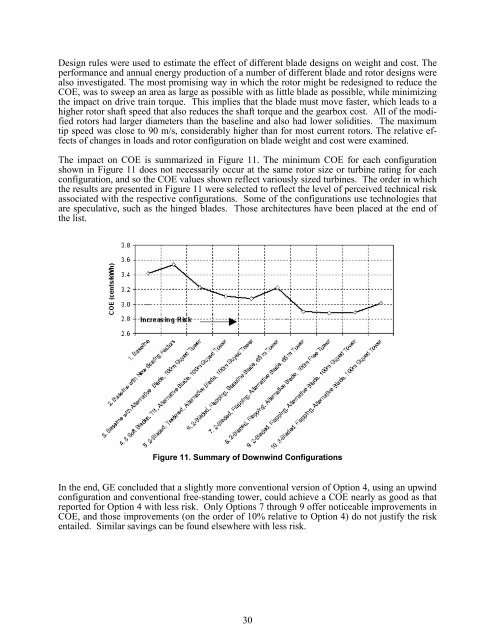Advanced Wind Turbine Program Next Generation Turbine ... - NREL
Advanced Wind Turbine Program Next Generation Turbine ... - NREL
Advanced Wind Turbine Program Next Generation Turbine ... - NREL
You also want an ePaper? Increase the reach of your titles
YUMPU automatically turns print PDFs into web optimized ePapers that Google loves.
Design rules were used to estimate the effect of different blade designs on weight and cost. The<br />
performance and annual energy production of a number of different blade and rotor designs were<br />
also investigated. The most promising way in which the rotor might be redesigned to reduce the<br />
COE, was to sweep an area as large as possible with as little blade as possible, while minimizing<br />
the impact on drive train torque. This implies that the blade must move faster, which leads to a<br />
higher rotor shaft speed that also reduces the shaft torque and the gearbox cost. All of the modified<br />
rotors had larger diameters than the baseline and also had lower solidities. The maximum<br />
tip speed was close to 90 m/s, considerably higher than for most current rotors. The relative effects<br />
of changes in loads and rotor configuration on blade weight and cost were examined.<br />
The impact on COE is summarized in Figure 11. The minimum COE for each configuration<br />
shown in Figure 11 does not necessarily occur at the same rotor size or turbine rating for each<br />
configuration, and so the COE values shown reflect variously sized turbines. The order in which<br />
the results are presented in Figure 11 were selected to reflect the level of perceived technical risk<br />
associated with the respective configurations. Some of the configurations use technologies that<br />
are speculative, such as the hinged blades. Those architectures have been placed at the end of<br />
the list.<br />
Figure 11. Summary of Downwind Configurations<br />
In the end, GE concluded that a slightly more conventional version of Option 4, using an upwind<br />
configuration and conventional free-standing tower, could achieve a COE nearly as good as that<br />
reported for Option 4 with less risk. Only Options 7 through 9 offer noticeable improvements in<br />
COE, and those improvements (on the order of 10% relative to Option 4) do not justify the risk<br />
entailed. Similar savings can be found elsewhere with less risk.<br />
30
















